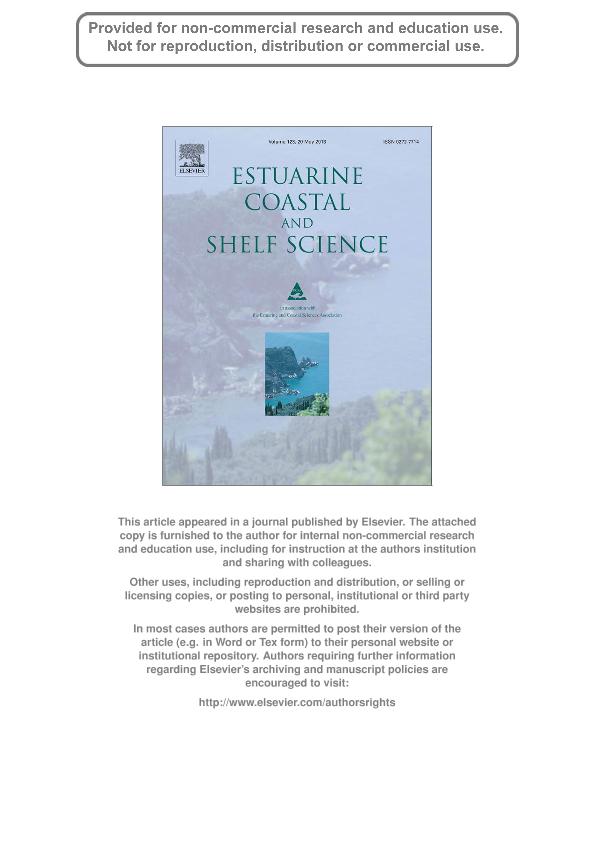Mostrar el registro sencillo del ítem
dc.contributor.author
Copello, Sofía

dc.contributor.author
Seco Pon, Juan Pablo

dc.contributor.author
Favero, Marco

dc.date.available
2017-10-05T19:24:14Z
dc.date.issued
2013-05
dc.identifier.citation
Copello, Sofía; Seco Pon, Juan Pablo; Favero, Marco; Use of marine space by Black-browed albatrosses during the non-breeding season
in the Southwest Atlantic Ocean; Academic Press Ltd-elsevier Science Ltd; Estuarine, Coastal and Shelf Science; 123; 5-2013; 34-38
dc.identifier.issn
0272-7714
dc.identifier.uri
http://hdl.handle.net/11336/26018
dc.description.abstract
Marine birds like albatrosses have shown a profound deterioration of their conservation status in recent years. The Black-browed albatross (Thalassarche melanophris) is the most abundant threatened albatross species in the Southwest Atlantic continental shelf. Declines in their breeding populations have been largely attributed to the impact of incidental mortality in fisheries. Data on at-sea distribution for the species during breeding is abundant, but movements of individuals during winter are poorly known. Here, we investigate the at-sea distribution of Black-browed albatrosses during the non-breeding seasons 2011 and 2012. Eleven adult individuals were captured at-sea and equipped with satellite tags. Distribution of tracked Black-browed albatrosses was mostly restricted to waters within the continental shelf of Argentina, Uruguay and southern Brazil; from 29 to 51 S. Two large marine areas, comprising the ca. 90% of the core area (50% utilization distribution) were identified; one from the mouth of Rio de la Plata toward the E and SE reaching the shelfbreak, and another in El Rincón estuary and waters to the South. Tracked birds were distributed over nine oceanographic regimes in the SW Atlantic continental shelf, spending between 5 and 34% of their time at sea in marine fronts of high productivity such as Río de la Plata, Los Patos lagoon estuary front, the shelfbreak and the mixed front. The identified core areas could be considered as proxy indicators of priority areas at the time of implementing conservation measures for the species. The analysis of overlapping with fisheries on the Argentinean Continental Shelf will provide further insights about critical areas where those measures should be more stringent.
dc.format
application/pdf
dc.language.iso
eng
dc.publisher
Academic Press Ltd-elsevier Science Ltd

dc.rights
info:eu-repo/semantics/openAccess
dc.rights.uri
https://creativecommons.org/licenses/by-nc-sa/2.5/ar/
dc.subject
Marine Birds
dc.subject
Habitat Use
dc.subject
Important Marine Areas
dc.subject
Oceanographic Fronts
dc.subject
Satellite Telemetry
dc.subject
Geographic Bounding Coordinates: : 30e55 S, 50e70 W
dc.subject.classification
Bioquímica y Biología Molecular

dc.subject.classification
Ciencias Biológicas

dc.subject.classification
CIENCIAS NATURALES Y EXACTAS

dc.title
Use of marine space by Black-browed albatrosses during the non-breeding season
in the Southwest Atlantic Ocean
dc.type
info:eu-repo/semantics/article
dc.type
info:ar-repo/semantics/artículo
dc.type
info:eu-repo/semantics/publishedVersion
dc.date.updated
2017-10-03T17:33:03Z
dc.journal.volume
123
dc.journal.pagination
34-38
dc.journal.pais
Estados Unidos

dc.journal.ciudad
New York
dc.description.fil
Fil: Copello, Sofía. Consejo Nacional de Investigaciones Científicas y Técnicas. Centro Científico Tecnológico Conicet - Mar del Plata. Instituto de Investigaciones Marinas y Costeras. Universidad Nacional de Mar del Plata. Facultad de Ciencia Exactas y Naturales. Instituto de Investigaciones Marinas y Costeras; Argentina
dc.description.fil
Fil: Seco Pon, Juan Pablo. Consejo Nacional de Investigaciones Científicas y Técnicas. Centro Científico Tecnológico Conicet - Mar del Plata. Instituto de Investigaciones Marinas y Costeras. Universidad Nacional de Mar del Plata. Facultad de Ciencia Exactas y Naturales. Instituto de Investigaciones Marinas y Costeras; Argentina
dc.description.fil
Fil: Favero, Marco. Consejo Nacional de Investigaciones Científicas y Técnicas. Centro Científico Tecnológico Conicet - Mar del Plata. Instituto de Investigaciones Marinas y Costeras. Universidad Nacional de Mar del Plata. Facultad de Ciencia Exactas y Naturales. Instituto de Investigaciones Marinas y Costeras; Argentina
dc.journal.title
Estuarine, Coastal and Shelf Science

dc.relation.alternativeid
info:eu-repo/semantics/altIdentifier/doi/http://dx.doi.org/10.1016/j.ecss.2013.02.016
dc.relation.alternativeid
info:eu-repo/semantics/altIdentifier/url/http://www.sciencedirect.com/science/article/pii/S0272771413001133
Archivos asociados
